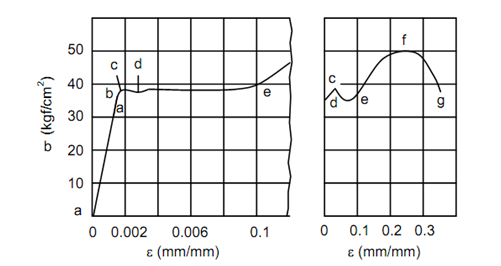Yield Strength
A material placed in a machine or structure to serve as a load carrying member is never allowed to deform plastically. Thus, designers often need to characterise a material by its elastic strength. There are two types of strength that might be recognised from diagram. They are "ideal" & practical elastic strengths. Ideal elastic strengths are, "elastic limit" & "proportional limit".
Proportional limit or a material is a stress up to which material has linear relationship between stress and strain. Elastic limit of a material is the stress up to which a material behaves elastically. The meaning of elasticity or elastic behaviour has already been explained.
In Figure stress level corresponding to point a is the proportional limit and that corresponding to point b is the elastic limit. Both the ideal strength values are hardly ever used in actual characterisation of material because of difficulties in their determination. Therefore, practical elastic strength values are defined & resolute.

Figure: (a) With Strain Scale Expanded Showing Yield Deformation and (b) With Strain Scale Shortened to Show Ultimate and Fracture Point along with Yield Point
The yielding behaviour of mild and structural steel is shown in Figure 6(a) on an expanded scale of abscissa or strain axis. This figure exphasises the fact that total deformation during yielding is about ten times the deformation upto elastic limit. The yielding is shown to end at point e beyond which the plastic deformation continues as is shown in Figure 6(b). The point c is the upper yield point and d the lower yield point. The difference between upper and lower yield point exists because movement of the ends of the specimen as produced by two machine cross-heads, does not proceed as fast as the yield deformation of material. This fact may be confirmed by allowing the loading cross- head to move very fast, which is the condition of the impact loading. In such a case only one yield point (i.e. the upper yield point) shall exist. For materials which show upper and lower yield points, the latter is taken as the "yield strength" because it is less affected by variables.